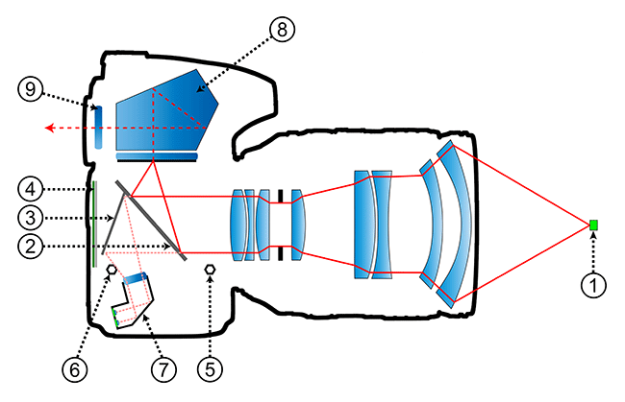Misunderstanding 1: The inability to focus at small apertures is nothing to do with amount of light. You still have a lot of light with f/8 in sunny day, much more than at f/2.8 indoors. It is actually related to Phase Detection AF mechanism which operates much like range finder comparing images from different angles to determine it’s in-focus or not. Small lens aperture just blocks light paths from different angles, and as the result, makes AF sensor unable to work reliably or not at all.
Misunderstanding 2: Older Nikon cameras may not auto-focus reliably with a lens having a maximum aperture smaller than f/5.6. That may sound bad, if you assume that it means the camera will not auto-focus reliably when the aperture is closed down to f/5.6. That is not what Nikon is saying! Instead they are telling us that auto-focus may not work reliably on older Nikon cameras with a lens having a maximum aperture of f/5.6, with the emphasis on the word maximum.
Principle of Split Image Focusing Aid in Phase Detect AF (PDAF) Mechanism
- In DSLR cameras, phase-detect AF systems work via the the use of internal baffles that allows the light to enter the camera, then be directed by the AF sub-mirror to the AF sub-system from different angles. AF sensor will analyze and compare those lights (from different angles) to determine if the image is in-focus or not, and tell the lens to adjust until the image is in-focus. If the aperture is too narrow (i.e. the area that lights enter the AF sensor is too small), the differences of the light angles will not be significant enough to allow AF sensor to work properly as designed.
- AF sensors of some older DSLR cameras can only work with lights coming from area as large as f/2.8 ring of lens; newer cameras can work with f/5.6 ring of lens; while newest cameras allow f/8 ring of lens.
- This issue noticeably matters when using tele-lenses, especially with teleconverter, in which maximum aperture is down to f/8 or f/11.
AF Sensitivity vs. Amount of light
- Fact: AF detection works better in better light condition;
- Fact: Larger apertures allow more light to enter camera;
- Fact: Nikon cameras use maximum aperture of the attached lens, not currently-closed-down aperture, while acquiring focus. For example, you currently set aperture at f/5.6 but your lens have max aperture of f/1.4, then the camera will use f/1.4 while acquiring focus; when you press the shutter, the camera will close the aperture down to f/5.6 before making the shoot.
- Newer cameras are equipped with newer AF detection sensor(s) which are more sensitive and allow higher reliable focus ability in lower light situations. This refers to AF EV Range terminology. (For example, AF EV Range of D850 is -4 EV, D750 is -3 EV, while D810/800 is only -2 EV).
F/8 AF Detection sensor(s) in different cameras
- Not all AF sensors in camera are the same. Only the center AF sensor in the 800/e and the D7100 is compatible with f/8 (the surrounding ones are “5.6 and up to but not quite f/8” ). So, if you have your D800/e set to something other than the center sensor and the D7100 is set to center, it will likely focus more reliably. The D810 has 01 f//8-compatible sensor, D750 have 11 sensors, and the D610 has 7 sensors – but they are around the center. (Note that this doesn’t mean you can’t get an AF lock with one of the other sensors with an effective f/8 lens, it just means the center will be more reliable.)
- Number of f/8-compatible sensor of some cameras:
- Nikon D850: Up to f/8, 15 sensors
- Nikon D810: Up to f/8, 1 sensor
- Nikon D800 / D800E: Up to f/8, 1 sensor
For reference: AF Module in DSLR camera
The AF sensors of DSLR cameras are not on the imaging sensor. They are at the bottom of the mirror box (see item 7 in the image below). 
Here is the description of each number shown in the above illustration:
- 1. Ray of light
- 2. Main/Reflex Mirror
- 3. Secondary Mirror, also known as “Sub-Mirror”
- 4. Camera Shutter and Image Sensor
- 5. Eccentric pin (1.5mm hex) for adjusting the Main Mirror
- 6. Eccentric pin (1.5mm hex) for adjusting the Secondary Mirror
- 7. Phase Detect Sensor (AF Sensor)
- 8. Pentaprism
- 9. Viewfinder
Reference:
